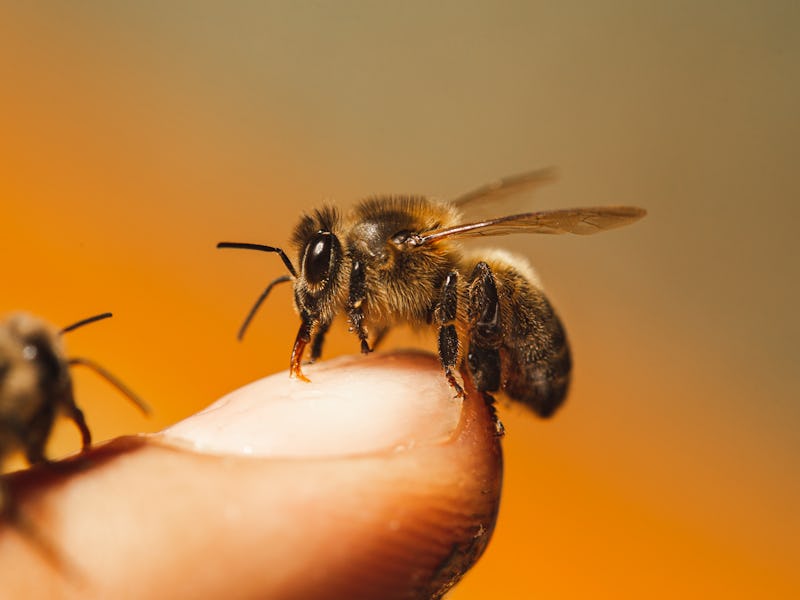Not All Bees Have a Queen. Two Bug Experts Explain Why.
Since lots of bees successfully live without a queen, what is it that queens provide for the bee species that do have them?

When you think “bee,” you likely picture one species that lives all over the world: the honey bee. And honey bees have queens, a female who lays essentially all of the eggs for the colony.
But most bees don’t have queens. With about 20,000 species of bees worldwide — that’s about 2 trillion bees — the majority of them don’t even live in groups. They do just fine without queens or colonies.
Instead, a single female lays eggs in a simple nest, either inside a plant stem or an underground tunnel. She provides each egg with a ball of pollen mixed with nectar that she collected from flowers, and she leaves the eggs to hatch and develop on their own. She doesn’t have anyone to help with this process.
These bee species, often spectacularly beautiful, are important pollinators of many crops and plants, though most people aren’t even aware of them.
Since lots of bees successfully live without a queen, what is it that queens provide for the bee species that do have them? We are behavioral ecologists who study social insects, and this question is at the heart of our research.
A queen, workers, and drones
The males have one task: to find and then mate with a female who may become a future queen.
Along with honey bees, two other kinds of bees also have queens: bumble bees, which are found on all continents except Australia and Antarctica, and stingless bees, which are found primarily in tropical areas.
One honey bee colony — also called a hive — may have more than 50,000 bees, while bumble bee colonies usually have just a few hundred bees. Stingless bee colonies are often small, but some are as large as the biggest honey bee hives.
These bees’ social structures have two more things in common besides the egg-laying queen: the female workers who care for the colony, and the males, sometimes called “drones.”
Notice the males are not included in the “worker” group. Males generally don’t help collect nectar or pollen, protect and maintain the hive, or care for the young larvae. The females do all of those jobs.
Instead, the males have one task: to find and then mate with a female who may become a future queen. After building their strength, males leave the hive to join thousands of other drones to wait for new queens that are also looking for mates. If males are lucky enough to mate, they pass away soon afterward. In contrast, females typically mate with many different males before starting their lives as egg-laying queens.
Female worker bees do pretty much all the work.
The isolated queen
Maybe you imagine a queen as the one in charge, ordering everyone around. But that’s a case of language being misleading. Unlike human queens who lead their people, bee queens don’t rule over their workers.
Instead, particularly for honey bees, the queen is rather isolated from what’s happening in the hive. Remember, she just lays eggs, up to 2,000 in a day. The workers surround and take care of her while managing the colony. The queen bee might live for a few years, much longer than female worker bees and drones.
Other animals also live in social groups with a division of labor between those who reproduce and those who maintain the colony. Ants, termites, and some wasps — like yellow jackets and hornets — have a similar kind of colony structure. So does the naked mole rat. Why did these groups evolve to have queens?
Family ties
A honey bee hive is a wonderfully complex structure.
One way for an organism to pass on genes is by having offspring.
Another way is to help close relatives, who are likely to share many of your same genes, to produce more offspring than they would if they were on their own.
This option is pretty much what happens in a bee colony. Those thousands of female worker bees may not themselves reproduce, but the queen is their mother. They help her produce another generation of siblings who will one day be their sisters. In this way, the female worker bees are passing their genes on to the next generation, just not directly.
Something else to consider: A honey bee hive is a wonderfully complex structure. The layers of wax combs built to store honey and raise offspring are a marvel of architecture and require a large workforce for construction, ongoing repairs, and protection from intruders or predators.
So you might ask: Which came first? Social groups with queens and workers producing large numbers of related offspring that required more elaborate nest structures? Or did the complex nest arise first, which led to greater success for groups that evolved to divide tasks among queens and workers?
These are fascinating questions that biologists have been exploring for decades. But both of these factors – the division of labor and the complex hive structures – help explain why there are bees with queens.
This article was originally published on The Conversation by Phil Starks at Tufts University and Aviva Liebert at Framingham State University. Read the original article here.